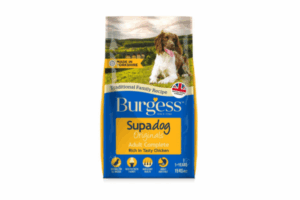When it comes to supermarket own-brand dog food, ASDA Hero represents one of Britain’s most accessible options for budget-conscious pet owners. Positioned as an everyday solution for feeding your four-legged companion without breaking the bank, this range has undergone significant changes in recent years, most notably a comprehensive rebranding in 2023. But does affordability necessarily come at the expense of quality? Let’s dig deeper into what ASDA Hero truly offers your canine companion.
Ingredient quality and nutritional profile
Examining ASDA Hero’s ingredient list reveals a composition that prioritizes cost-efficiency over premium nutrition. Taking the Senior Chicken, Rice & Vegetables formula as an example, we find a product containing:
- Cereals (30% total with 4% rice specifically mentioned)
- Meat and animal derivatives (24% total, including just 4% chicken)
- Vegetables (4% peas)
- Various oils, fats and additives
The relatively low meat content is immediately apparent, with unnamed “meat and animal derivatives” making up the majority of the protein sources. This lack of transparency regarding specific protein origins is concerning for dogs with food sensitivities or allergies. Premium brands typically name exact meat sources and include higher percentages.
Nutritionally, the analytical constituents show about 21% crude protein and 8.5% crude fats. These values satisfy basic requirements but fall short compared to higher-end products offering 25-35% protein from named meat sources. The heavy reliance on cereals as filler ingredients may not suit all dogs, particularly those requiring grain-free diets.
One positive inclusion is the addition of functional supplements like glucosamine and chondroitin for joint support, prebiotics from chicory root for digestive health, and omega-3 fatty acids (0.3%) for skin and coat maintenance. However, the quantities provided are modest compared to specialized formulations.
Price point and value proposition
ASDA Hero’s primary appeal lies in its affordability. With dry food typically priced between £10-£15 per bag and wet food pouches under £1, it represents one of the most economical options in UK supermarkets. Feeding a 30kg dog costs approximately £0.50-£0.80 daily, offering substantial savings compared to premium alternatives.
This value proposition makes Hero an attractive option for pet owners facing financial constraints. Not sure whether to choose ASDA Hero or Webbox? Read our other Webbox review for another budget-friendly alternative that might better suit your dog’s needs.
The cost-saving benefit must be weighed against potential nutritional compromises. While Hero meets minimum standards for complete nutrition, its heavy reliance on cereals and limited named meat content means owners might need to feed larger quantities to satisfy their pets, potentially offsetting some savings.
Recent rebranding and packaging innovations
In 2023, ASDA collaborated with design agency STORMBRANDS to overhaul the Hero range’s visual identity. This strategic rebrand aimed to shift perception from mere pet ownership toward “pet parenthood,” aligning with evolving consumer trends.
The updated packaging features expressive pet imagery, softer color palettes, and clearer life-stage labeling to improve shelf appeal. These changes were designed to compete more effectively with premium brands while maintaining ASDA’s value-oriented market position.
However, it’s worth noting that while the packaging received a comprehensive update, the formulations themselves appear unchanged. This creates a potential disconnect between the modernized brand image and the actual product quality inside.
Consumer feedback and reported issues
Reviews of ASDA Hero present a mixed picture. Some owners report satisfactory experiences, particularly those with dogs having robust digestive systems and no specific dietary requirements. The palatability seems adequate for many pets, with several owners noting their dogs consume the food willingly.
Unfortunately, more concerning patterns emerge in consumer feedback. Multiple reports cite digestive issues including vomiting, diarrhea, and loose stools. Particularly troubling are accounts from German Shepherd owners and those with sensitive breeds describing “violently sick” reactions and “runny RED poo” that resolved only after switching to different foods.
There have also been isolated but alarming reports of foreign objects found in the food. Such complaints, though rare, raise questions about quality control measures. The relatively high number of digestive complaints suggests that dogs with sensitive stomachs might struggle with this food’s composition.
Comparative market position
Within the UK pet food landscape, ASDA Hero occupies a distinct niche. It offers a price advantage over mid-range and premium brands while providing slightly better nutritional credentials than the very cheapest alternatives.
The 2023 packaging redesign attempted to narrow the perceived quality gap between Hero and more expensive competitors. However, when examining actual nutritional profiles and ingredient transparency, significant differences remain. Brands focusing on higher meat content, grain-free formulations, or hypoallergenic properties generally cost substantially more but offer nutritional benefits that budget options cannot match.
ASDA has recently begun stocking alternative brands like Scrumbles, which offers higher meat content (60-75%) but at premium prices, providing customers with more options across different budget levels.
What kind of dogs is this food suitable for?
ASDA Hero offers variants across multiple life stages, including puppy, adult, senior and working dog formulations. However, its suitability depends more on individual circumstances than specific age groups.
This food is most appropriate for adult dogs with robust digestive systems and no specific dietary sensitivities or allergies. The moderate protein levels and basic nutritional profile can maintain healthy dogs with average activity levels, particularly those without known food intolerances.
The senior formula, with added joint supplements, provides theoretical benefits for older dogs, though the concentrations of glucosamine and chondroitin are likely lower than specialized joint-support diets. Similarly, the working dog formula offers slightly higher protein but may not deliver sufficient nutrition for highly active working breeds.
ASDA Hero is less suitable for puppies of large or giant breeds requiring carefully balanced nutrition for proper development, dogs with known grain allergies or sensitivities, and those with specific protein requirements or intolerances. The vague labeling of meat derivatives makes it difficult to identify and avoid potential allergens.
Budget-conscious owners of dogs with uncomplicated nutritional needs may find Hero acceptable, but those with sensitive pets should consider alternatives, even if they cost more. The reported digestive issues suggest particular caution for breeds prone to gastrointestinal problems.
Is this dog food good? An honest conclusion
As a dog food specialist examining ASDA Hero objectively, I must conclude that this is an average to below-average product when compared against the broader market. While it meets basic nutritional requirements and offers exceptional affordability, several factors prevent a more positive assessment.
The reliance on unnamed meat derivatives and high cereal content indicates a formulation prioritizing cost over optimal canine nutrition. The 24% total meat content (with only 4% identified as chicken in some variants) falls considerably short of what nutritionists typically recommend for optimal canine health.
The consistent pattern of digestive complaints among consumers raises legitimate concerns about ingredient quality and digestibility. While many dogs may tolerate this food without obvious issues, the nutritional profile suggests they might not be receiving optimal nutrition for long-term health.
ASDA Hero represents a compromise option for financially constrained pet owners. It provides complete basic nutrition at an accessible price point but makes significant concessions in ingredient quality and transparency. For short-term use or for dogs with uncomplicated dietary needs, it may prove adequate, but it cannot be recommended as an ideal long-term nutritional solution for most dogs.
The recent packaging redesign, while visually appealing, has not addressed the fundamental limitations in the product itself. Pet owners should approach this food with realistic expectations about the quality-price trade-off it represents.
Better alternatives for your dog’s nutrition
If you’re concerned about providing truly optimal nutrition for your canine companion, it’s worth exploring higher-quality alternatives. In our comprehensive comparison of dog food brands, Butternut Box consistently ranked as the best dog food available in the UK market today.
Butternut Box offers human-grade ingredients, personalized portion control and significantly higher meat content without mysterious “derivatives” or fillers. While it represents a higher investment in your pet’s nutrition, many owners report improvements in coat condition, energy levels and digestive health after switching. For a detailed analysis of what makes this premium option stand out, check out our honest Butternut Box review to determine if upgrading your dog’s diet might be worthwhile for your particular situation.






